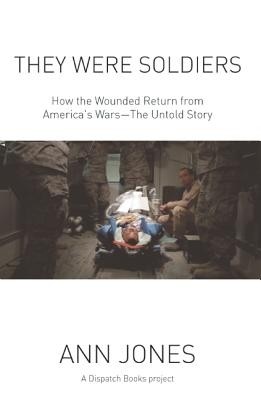 “They Were Soldiers” is a horrifying book. No, it’s not filled with ghosts, goblins, or vampires and it’s not badly written, boring, or unintelligible. But in chronicling the physical and psychological pain of America’s returning soldiers, sailors and Marines, it casts an uncompromising eye on the devastation hundreds of thousands of men and women live, and sometimes die, trying to manage.
“They Were Soldiers” is a horrifying book. No, it’s not filled with ghosts, goblins, or vampires and it’s not badly written, boring, or unintelligible. But in chronicling the physical and psychological pain of America’s returning soldiers, sailors and Marines, it casts an uncompromising eye on the devastation hundreds of thousands of men and women live, and sometimes die, trying to manage.
While the book avoids polemical arguments, choosing instead to focus on the personal stories of veterans and their families, it is hard not to see the text as an argument against armed struggle and war. Indeed, most of the accounts are gut-churning, leaving the reader to question why the world’s people have yet to develop non-violent methods of settling international disputes and protecting their homelands. Furthermore, it asks a trenchant question: What price are we willing to pay, in human terms, to win national sovereignty or obtain unfettered access to oil or other resources?
Jones posits neither suggestions nor answers. Instead, she focuses on the many ways war damages recruits, career militarists, and the people who love them. She is an ace reporter and spent considerable time embedded with US troops in Afghanistan and Iraq, and later interviewed hundreds of wounded warriors in both German and US hospitals. The folly of the tragedies she describes is monumental.
For example, although the Soviets fled Afghanistan in 1989, 25 years later the country remains strewn with more landmines than anyplace else on earth. “De-mining never progressed very far,†Jones writes. “Landmines still kill or disable Afghans at the rate of 30 to 60 every month. Afghans know that walking around in the countryside is very dangerous, but when American generals resurrected counterinsurgency [COIN] doctrine from the war in Vietnam, they ordered soldiers to get out of their vehicles and conduct dismounted patrols. It is possible that American COIN tactics cause as many explosive injuries as the Taliban, but no one keeps score…All the signatures of the war in Afghanistan are written on bodies,: pulverized legs that probably will be amputated, shrapnel from the blast, concussions, possible traumatic injury to the brain, and traumatic shock that might haunt an Afghan or be diagnosed in an American as Post Traumatic Stress Disorder.â€
Even after treatment, Jones reports that the pain and trauma linger. For some, the aftermath of injury involves learning to live without one or more limbs or having to adjust to using prosthetic appliances. For others, especially men injured by Improvised Explosive Devices [IEDs], the damage typically involves their scrotum and testicles. Again Jones unflinchingly describes the impact: “Since the testicles produce testosterone, he still faces the inevitable ill effects of a deficient supply—a long and imperfectly-understood list headed by osteoporosis, metabolic syndrome, cardiovascular problems including coronary artery disease and atherosclerosis, erectile dysfunction with its attendant psychological difficulties, low sperm count impairing fertility, obesity, depression, and a lifetime seesaw of hormonal treatments.â€
Small wonder that many veterans resort to drugs and alcohol to self-medicate. What’s more, Jones reports that the number of suicides among vets has skyrocketed to a staggering 18 a day.
Equally appalling, Jones notes that when partners and spouses ask the Veteran’s Administration for help, they are often greeted with platitudes. The motto, Accept, Adapt, and Adjust Your Attitude, is repeated as a mantra, and service members are typically referred to Anger Management classes when they show rage or behave violently. Similarly, servicewomen who’ve been sexually assaulted or raped are treated dismissively and Jones reports that most avoid seeking help from the VA because the military did so little to protect them during their enlistment. Not surprisingly, she continues, many end up as substance abusers; a disproportionate number are homeless.
This, of course, could be changed—even without dismantling the war machine or pursuing pacifism. Take the issue of who is allowed to join the military. Jones notes that the Pentagon lowered standards to fill the ranks of our volunteer army, essentially giving a free pass to high school dropouts, gangbangers, neo-Nazis, drug addicts. and convicted felons. “Just three years following the invasion of Iraq,†she writes, “the military issued free passes—so called ‘moral waivers’—to one of every five recruits, including more than 58,000 convicted drug users and 1,605 with serious felony convictions for offenses including rape, kidnapping, and murder. When the number of free passes rose in the fourth year, the Pentagon changed the label to ‘conduct waivers.’â€
The upshot is that we have a system that fails on multiple levels and that operates with nearly no public scrutiny. We don’t see war—or warriors– on the nightly news or on our Yahoo or Facebook news feeds. And unless we personally know someone who is fighting, it’s easy to forget the bloodshed and agony of distant conflicts.
The horror Jones presents is upsetting and awful. That said, by making a largely-invisible issue visible, she has done a wonderful thing. They Were Soldiers should be read by everyone considering signing up for military service as well as their families and friends. Even more important, it should be required reading for every member of Congress—an assignment to be completed before voting on war appropriations or the budgets of Veteran’s Affairs agencies.
They Were Soldiers: How the Wounded Return from America’s Wars—The Untold Story, by Ann Jones, Haymarket Books, 2013, 192 pages, $12.95 paperback.

Leave a Reply